Challenges and Growth of SMEs: A Report on Ensoft Ltd.
VerifiedAdded on 2021/01/01
|12
|3955
|425
Report
AI Summary
This report provides an in-depth analysis of Small and Medium Enterprises (SMEs), focusing on Ensoft Ltd., a software company. It examines the current challenges faced by SMEs, including technological changes, security threats, government regulations, and financial constraints. The report delves into the entrepreneurial process, outlining key stages such as idea generation, business plan development, and funding. It highlights the nature and characteristics of SMEs, including their reliance on limited resources and community-based operations. The report also explores external environmental factors, such as economic conditions, competition, and political influences, and assesses various growth and development strategies, including market penetration, market expansion, and diversification. The analysis covers the current growth strategies of Ensoft Ltd., emphasizing the importance of marketing, innovation, and government initiatives for SME success.
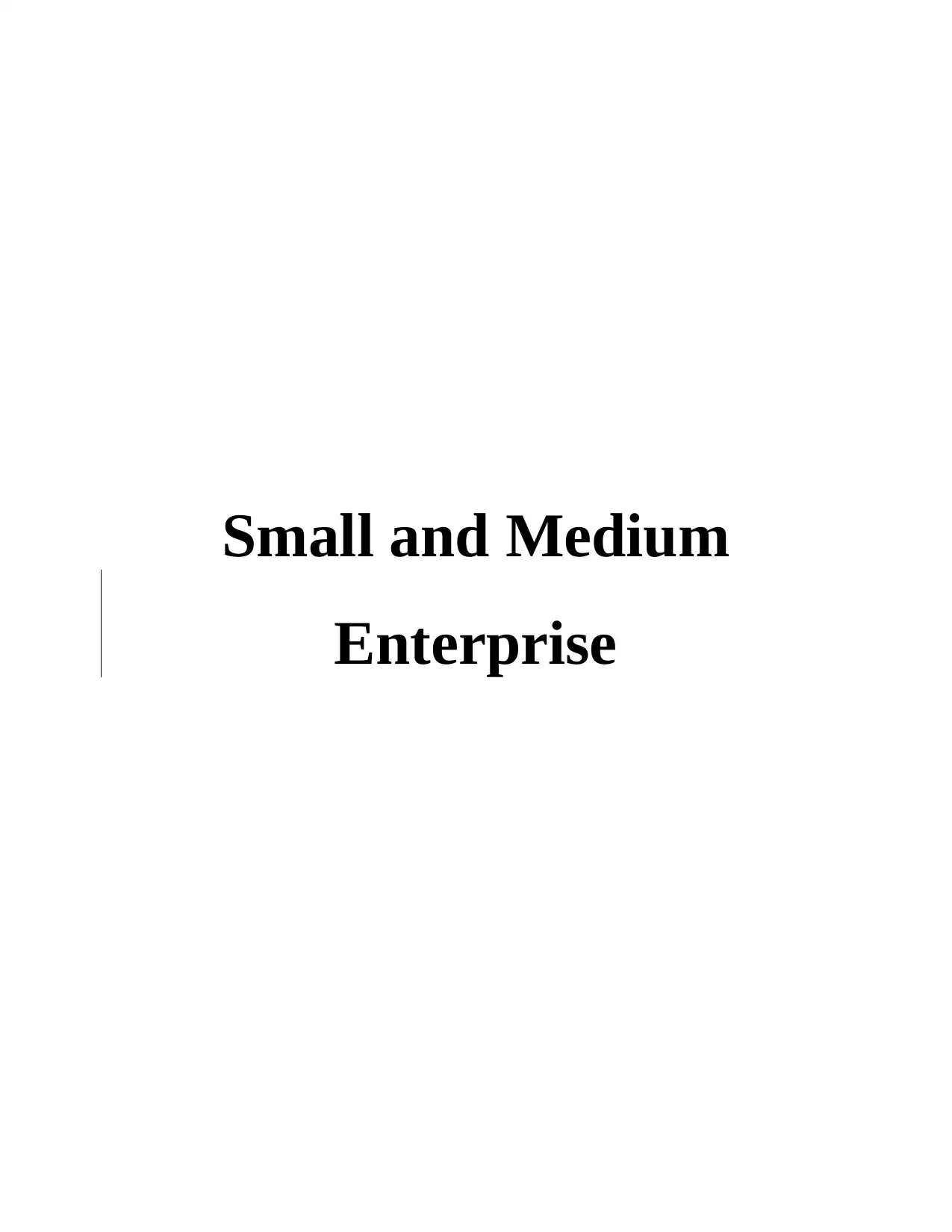
Small and Medium
Enterprise
Enterprise
Paraphrase This Document
Need a fresh take? Get an instant paraphrase of this document with our AI Paraphraser

Executive summary.?
Table of Contents
INTRODUCTION...........................................................................................................................3
TASK...............................................................................................................................................3
REFERENCES..............................................................................................................................12
Table of Contents
INTRODUCTION...........................................................................................................................3
TASK...............................................................................................................................................3
REFERENCES..............................................................................................................................12
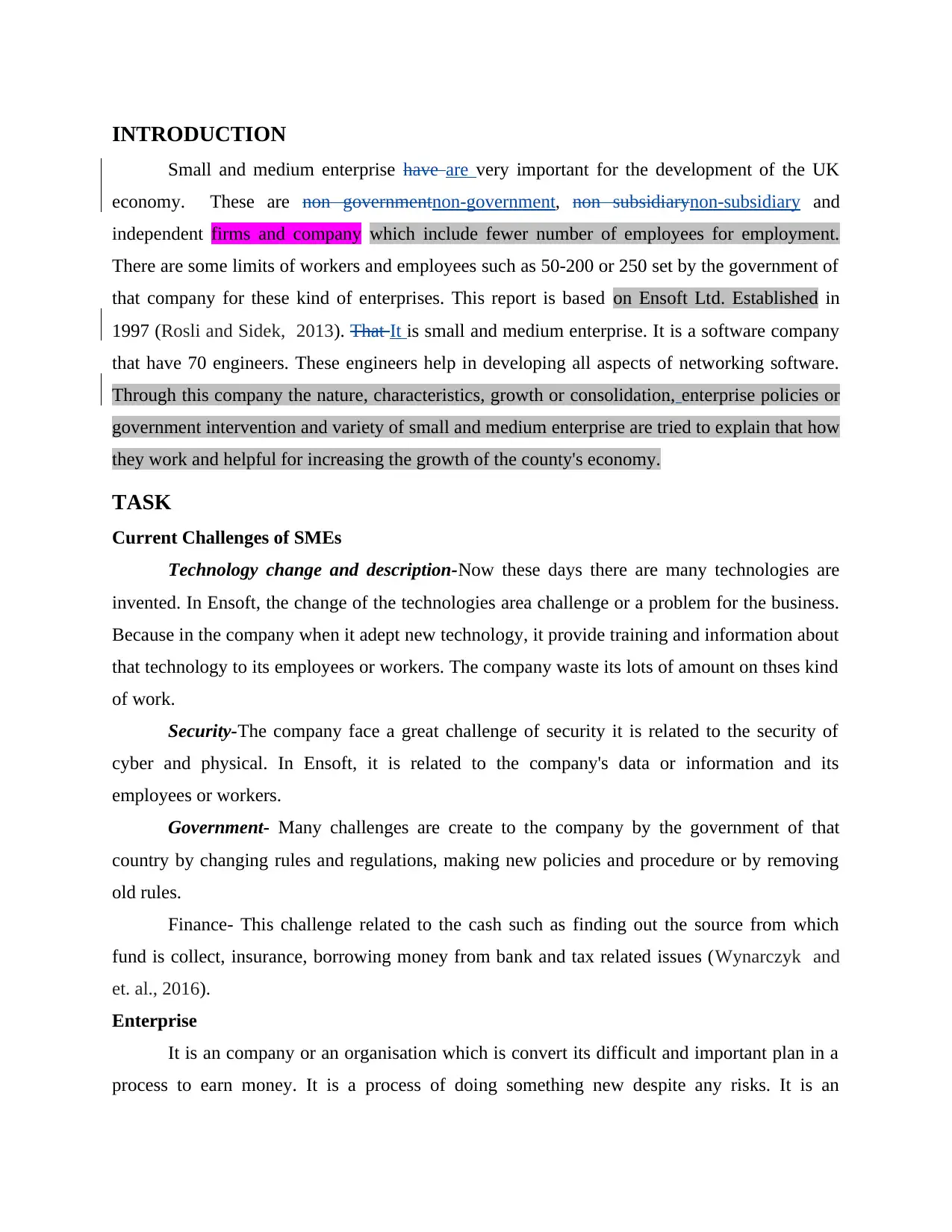
INTRODUCTION
Small and medium enterprise have are very important for the development of the UK
economy. These are non governmentnon-government, non subsidiarynon-subsidiary and
independent firms and company which include fewer number of employees for employment.
There are some limits of workers and employees such as 50-200 or 250 set by the government of
that company for these kind of enterprises. This report is based on Ensoft Ltd. Established in
1997 (Rosli and Sidek, 2013). That It is small and medium enterprise. It is a software company
that have 70 engineers. These engineers help in developing all aspects of networking software.
Through this company the nature, characteristics, growth or consolidation, enterprise policies or
government intervention and variety of small and medium enterprise are tried to explain that how
they work and helpful for increasing the growth of the county's economy.
TASK
Current Challenges of SMEs
Technology change and description-Now these days there are many technologies are
invented. In Ensoft, the change of the technologies area challenge or a problem for the business.
Because in the company when it adept new technology, it provide training and information about
that technology to its employees or workers. The company waste its lots of amount on thses kind
of work.
Security-The company face a great challenge of security it is related to the security of
cyber and physical. In Ensoft, it is related to the company's data or information and its
employees or workers.
Government- Many challenges are create to the company by the government of that
country by changing rules and regulations, making new policies and procedure or by removing
old rules.
Finance- This challenge related to the cash such as finding out the source from which
fund is collect, insurance, borrowing money from bank and tax related issues (Wynarczyk and
et. al., 2016).
Enterprise
It is an company or an organisation which is convert its difficult and important plan in a
process to earn money. It is a process of doing something new despite any risks. It is an
Small and medium enterprise have are very important for the development of the UK
economy. These are non governmentnon-government, non subsidiarynon-subsidiary and
independent firms and company which include fewer number of employees for employment.
There are some limits of workers and employees such as 50-200 or 250 set by the government of
that company for these kind of enterprises. This report is based on Ensoft Ltd. Established in
1997 (Rosli and Sidek, 2013). That It is small and medium enterprise. It is a software company
that have 70 engineers. These engineers help in developing all aspects of networking software.
Through this company the nature, characteristics, growth or consolidation, enterprise policies or
government intervention and variety of small and medium enterprise are tried to explain that how
they work and helpful for increasing the growth of the county's economy.
TASK
Current Challenges of SMEs
Technology change and description-Now these days there are many technologies are
invented. In Ensoft, the change of the technologies area challenge or a problem for the business.
Because in the company when it adept new technology, it provide training and information about
that technology to its employees or workers. The company waste its lots of amount on thses kind
of work.
Security-The company face a great challenge of security it is related to the security of
cyber and physical. In Ensoft, it is related to the company's data or information and its
employees or workers.
Government- Many challenges are create to the company by the government of that
country by changing rules and regulations, making new policies and procedure or by removing
old rules.
Finance- This challenge related to the cash such as finding out the source from which
fund is collect, insurance, borrowing money from bank and tax related issues (Wynarczyk and
et. al., 2016).
Enterprise
It is an company or an organisation which is convert its difficult and important plan in a
process to earn money. It is a process of doing something new despite any risks. It is an
⊘ This is a preview!⊘
Do you want full access?
Subscribe today to unlock all pages.

Trusted by 1+ million students worldwide
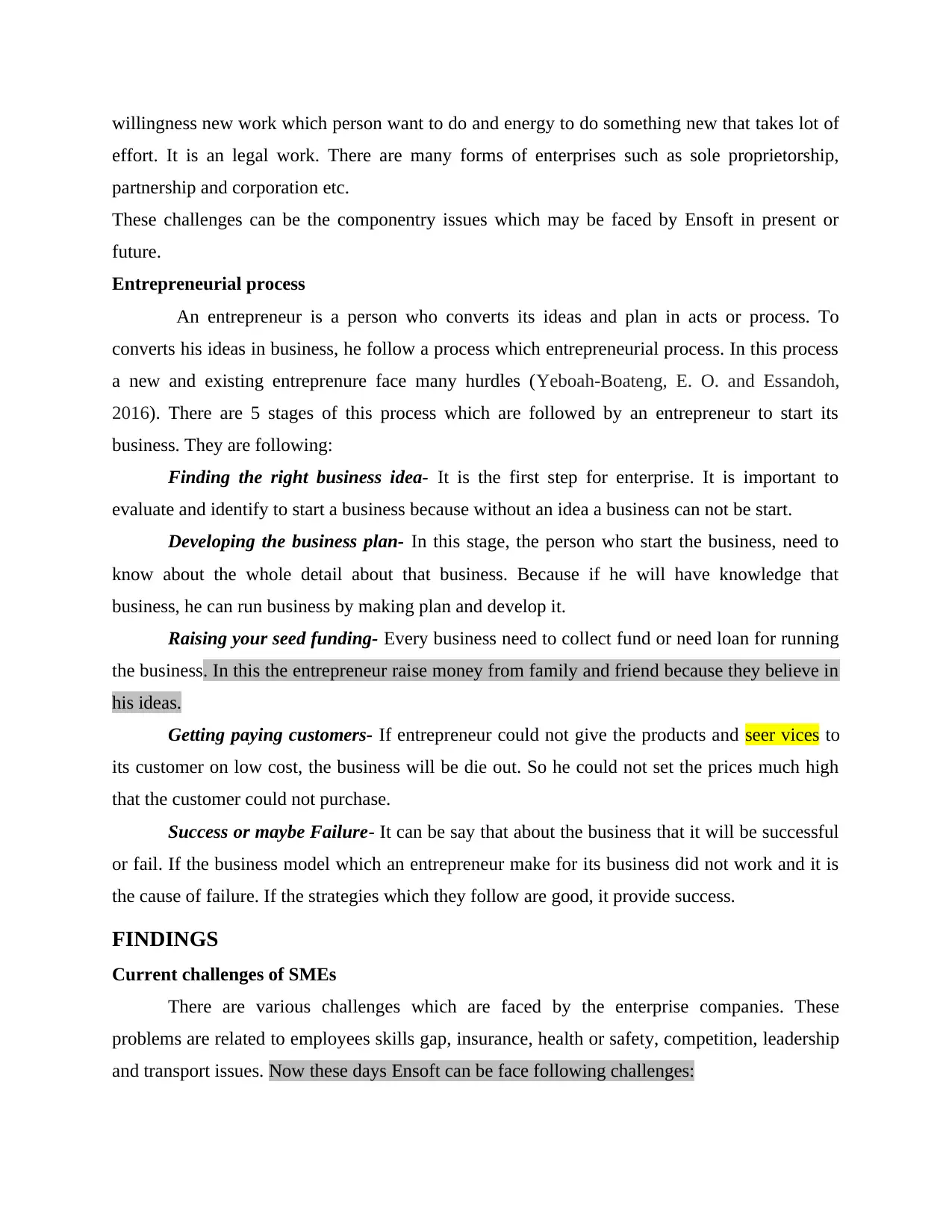
willingness new work which person want to do and energy to do something new that takes lot of
effort. It is an legal work. There are many forms of enterprises such as sole proprietorship,
partnership and corporation etc.
These challenges can be the componentry issues which may be faced by Ensoft in present or
future.
Entrepreneurial process
An entrepreneur is a person who converts its ideas and plan in acts or process. To
converts his ideas in business, he follow a process which entrepreneurial process. In this process
a new and existing entreprenure face many hurdles (Yeboah-Boateng, E. O. and Essandoh,
2016). There are 5 stages of this process which are followed by an entrepreneur to start its
business. They are following:
Finding the right business idea- It is the first step for enterprise. It is important to
evaluate and identify to start a business because without an idea a business can not be start.
Developing the business plan- In this stage, the person who start the business, need to
know about the whole detail about that business. Because if he will have knowledge that
business, he can run business by making plan and develop it.
Raising your seed funding- Every business need to collect fund or need loan for running
the business. In this the entrepreneur raise money from family and friend because they believe in
his ideas.
Getting paying customers- If entrepreneur could not give the products and seer vices to
its customer on low cost, the business will be die out. So he could not set the prices much high
that the customer could not purchase.
Success or maybe Failure- It can be say that about the business that it will be successful
or fail. If the business model which an entrepreneur make for its business did not work and it is
the cause of failure. If the strategies which they follow are good, it provide success.
FINDINGS
Current challenges of SMEs
There are various challenges which are faced by the enterprise companies. These
problems are related to employees skills gap, insurance, health or safety, competition, leadership
and transport issues. Now these days Ensoft can be face following challenges:
effort. It is an legal work. There are many forms of enterprises such as sole proprietorship,
partnership and corporation etc.
These challenges can be the componentry issues which may be faced by Ensoft in present or
future.
Entrepreneurial process
An entrepreneur is a person who converts its ideas and plan in acts or process. To
converts his ideas in business, he follow a process which entrepreneurial process. In this process
a new and existing entreprenure face many hurdles (Yeboah-Boateng, E. O. and Essandoh,
2016). There are 5 stages of this process which are followed by an entrepreneur to start its
business. They are following:
Finding the right business idea- It is the first step for enterprise. It is important to
evaluate and identify to start a business because without an idea a business can not be start.
Developing the business plan- In this stage, the person who start the business, need to
know about the whole detail about that business. Because if he will have knowledge that
business, he can run business by making plan and develop it.
Raising your seed funding- Every business need to collect fund or need loan for running
the business. In this the entrepreneur raise money from family and friend because they believe in
his ideas.
Getting paying customers- If entrepreneur could not give the products and seer vices to
its customer on low cost, the business will be die out. So he could not set the prices much high
that the customer could not purchase.
Success or maybe Failure- It can be say that about the business that it will be successful
or fail. If the business model which an entrepreneur make for its business did not work and it is
the cause of failure. If the strategies which they follow are good, it provide success.
FINDINGS
Current challenges of SMEs
There are various challenges which are faced by the enterprise companies. These
problems are related to employees skills gap, insurance, health or safety, competition, leadership
and transport issues. Now these days Ensoft can be face following challenges:
Paraphrase This Document
Need a fresh take? Get an instant paraphrase of this document with our AI Paraphraser
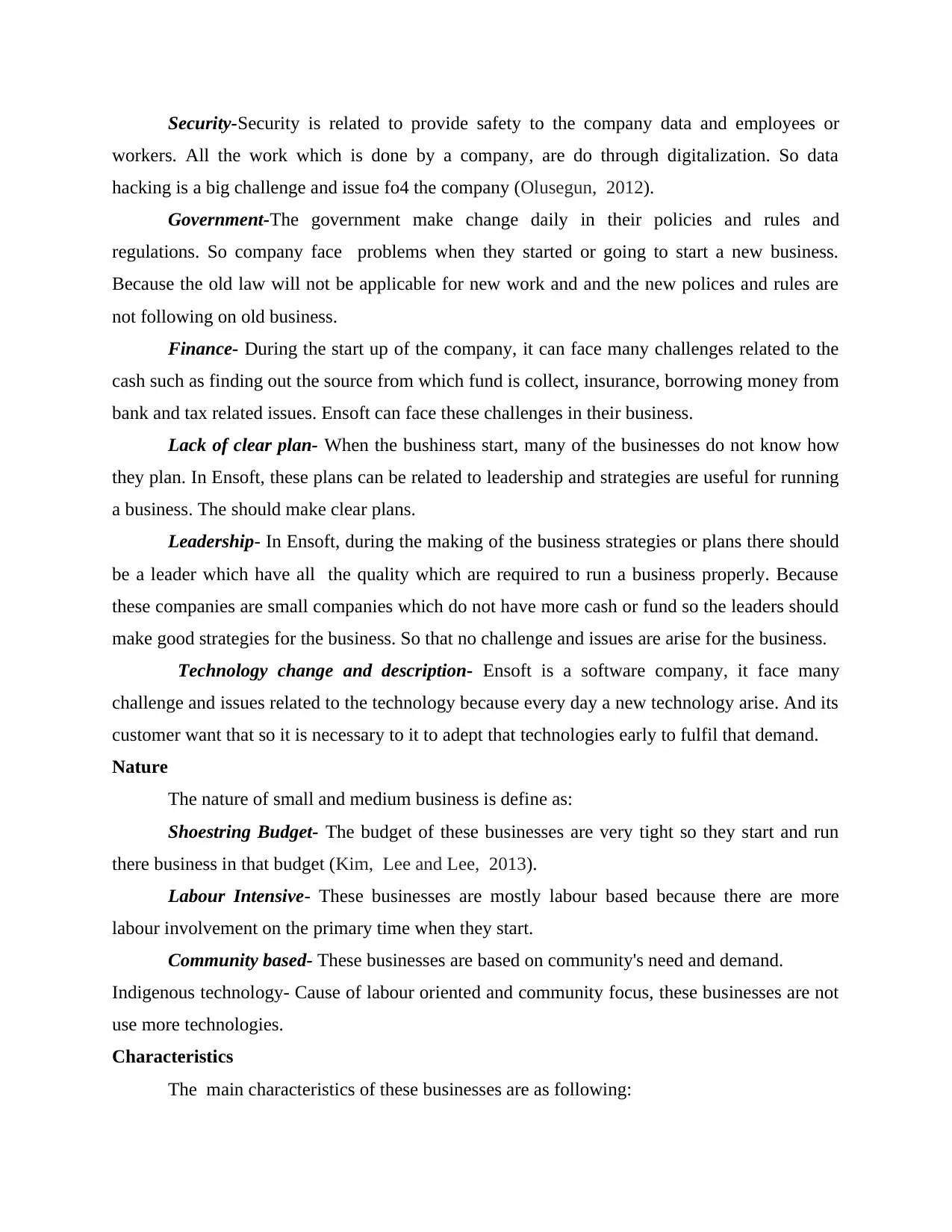
Security-Security is related to provide safety to the company data and employees or
workers. All the work which is done by a company, are do through digitalization. So data
hacking is a big challenge and issue fo4 the company (Olusegun, 2012).
Government-The government make change daily in their policies and rules and
regulations. So company face problems when they started or going to start a new business.
Because the old law will not be applicable for new work and and the new polices and rules are
not following on old business.
Finance- During the start up of the company, it can face many challenges related to the
cash such as finding out the source from which fund is collect, insurance, borrowing money from
bank and tax related issues. Ensoft can face these challenges in their business.
Lack of clear plan- When the bushiness start, many of the businesses do not know how
they plan. In Ensoft, these plans can be related to leadership and strategies are useful for running
a business. The should make clear plans.
Leadership- In Ensoft, during the making of the business strategies or plans there should
be a leader which have all the quality which are required to run a business properly. Because
these companies are small companies which do not have more cash or fund so the leaders should
make good strategies for the business. So that no challenge and issues are arise for the business.
Technology change and description- Ensoft is a software company, it face many
challenge and issues related to the technology because every day a new technology arise. And its
customer want that so it is necessary to it to adept that technologies early to fulfil that demand.
Nature
The nature of small and medium business is define as:
Shoestring Budget- The budget of these businesses are very tight so they start and run
there business in that budget (Kim, Lee and Lee, 2013).
Labour Intensive- These businesses are mostly labour based because there are more
labour involvement on the primary time when they start.
Community based- These businesses are based on community's need and demand.
Indigenous technology- Cause of labour oriented and community focus, these businesses are not
use more technologies.
Characteristics
The main characteristics of these businesses are as following:
workers. All the work which is done by a company, are do through digitalization. So data
hacking is a big challenge and issue fo4 the company (Olusegun, 2012).
Government-The government make change daily in their policies and rules and
regulations. So company face problems when they started or going to start a new business.
Because the old law will not be applicable for new work and and the new polices and rules are
not following on old business.
Finance- During the start up of the company, it can face many challenges related to the
cash such as finding out the source from which fund is collect, insurance, borrowing money from
bank and tax related issues. Ensoft can face these challenges in their business.
Lack of clear plan- When the bushiness start, many of the businesses do not know how
they plan. In Ensoft, these plans can be related to leadership and strategies are useful for running
a business. The should make clear plans.
Leadership- In Ensoft, during the making of the business strategies or plans there should
be a leader which have all the quality which are required to run a business properly. Because
these companies are small companies which do not have more cash or fund so the leaders should
make good strategies for the business. So that no challenge and issues are arise for the business.
Technology change and description- Ensoft is a software company, it face many
challenge and issues related to the technology because every day a new technology arise. And its
customer want that so it is necessary to it to adept that technologies early to fulfil that demand.
Nature
The nature of small and medium business is define as:
Shoestring Budget- The budget of these businesses are very tight so they start and run
there business in that budget (Kim, Lee and Lee, 2013).
Labour Intensive- These businesses are mostly labour based because there are more
labour involvement on the primary time when they start.
Community based- These businesses are based on community's need and demand.
Indigenous technology- Cause of labour oriented and community focus, these businesses are not
use more technologies.
Characteristics
The main characteristics of these businesses are as following:
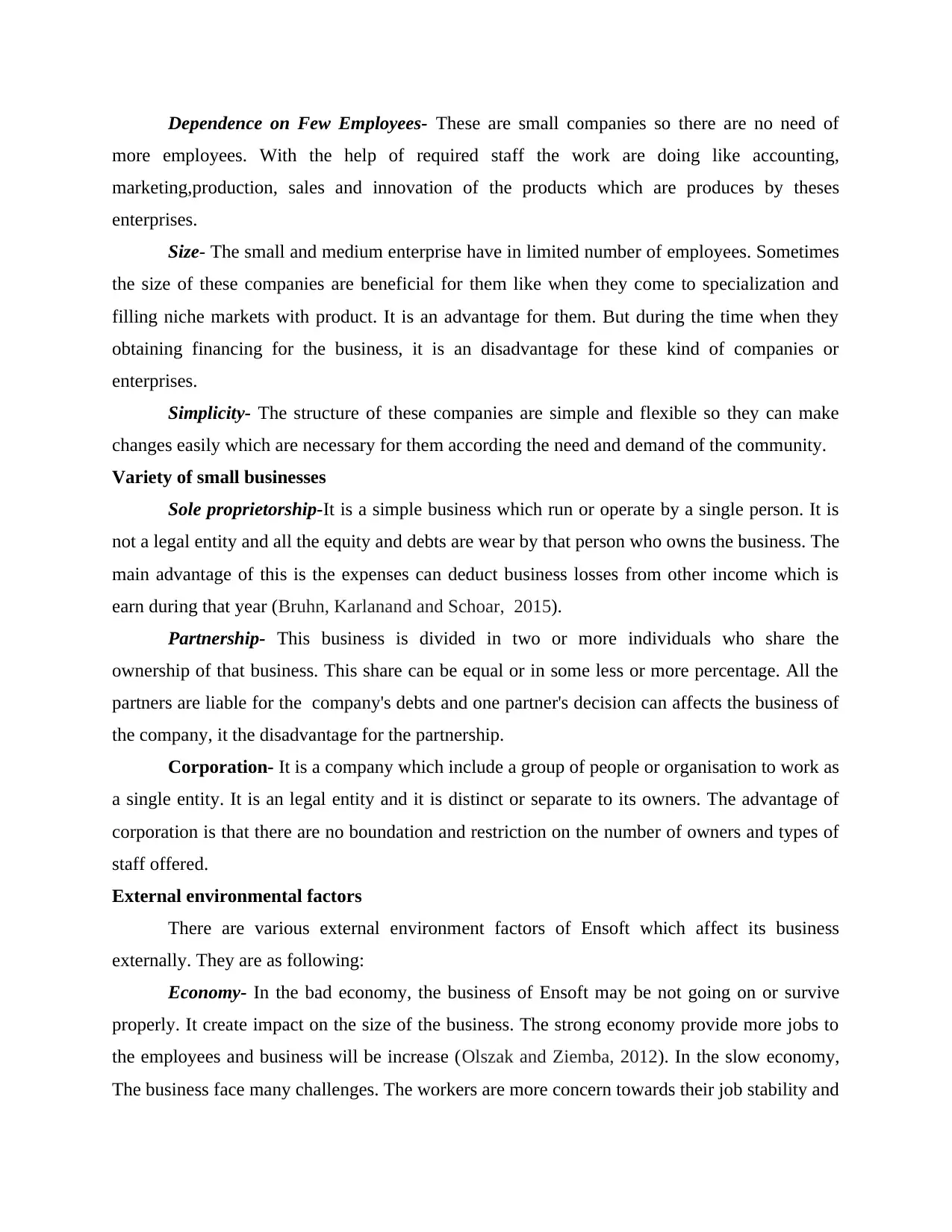
Dependence on Few Employees- These are small companies so there are no need of
more employees. With the help of required staff the work are doing like accounting,
marketing,production, sales and innovation of the products which are produces by theses
enterprises.
Size- The small and medium enterprise have in limited number of employees. Sometimes
the size of these companies are beneficial for them like when they come to specialization and
filling niche markets with product. It is an advantage for them. But during the time when they
obtaining financing for the business, it is an disadvantage for these kind of companies or
enterprises.
Simplicity- The structure of these companies are simple and flexible so they can make
changes easily which are necessary for them according the need and demand of the community.
Variety of small businesses
Sole proprietorship-It is a simple business which run or operate by a single person. It is
not a legal entity and all the equity and debts are wear by that person who owns the business. The
main advantage of this is the expenses can deduct business losses from other income which is
earn during that year (Bruhn, Karlanand and Schoar, 2015).
Partnership- This business is divided in two or more individuals who share the
ownership of that business. This share can be equal or in some less or more percentage. All the
partners are liable for the company's debts and one partner's decision can affects the business of
the company, it the disadvantage for the partnership.
Corporation- It is a company which include a group of people or organisation to work as
a single entity. It is an legal entity and it is distinct or separate to its owners. The advantage of
corporation is that there are no boundation and restriction on the number of owners and types of
staff offered.
External environmental factors
There are various external environment factors of Ensoft which affect its business
externally. They are as following:
Economy- In the bad economy, the business of Ensoft may be not going on or survive
properly. It create impact on the size of the business. The strong economy provide more jobs to
the employees and business will be increase (Olszak and Ziemba, 2012). In the slow economy,
The business face many challenges. The workers are more concern towards their job stability and
more employees. With the help of required staff the work are doing like accounting,
marketing,production, sales and innovation of the products which are produces by theses
enterprises.
Size- The small and medium enterprise have in limited number of employees. Sometimes
the size of these companies are beneficial for them like when they come to specialization and
filling niche markets with product. It is an advantage for them. But during the time when they
obtaining financing for the business, it is an disadvantage for these kind of companies or
enterprises.
Simplicity- The structure of these companies are simple and flexible so they can make
changes easily which are necessary for them according the need and demand of the community.
Variety of small businesses
Sole proprietorship-It is a simple business which run or operate by a single person. It is
not a legal entity and all the equity and debts are wear by that person who owns the business. The
main advantage of this is the expenses can deduct business losses from other income which is
earn during that year (Bruhn, Karlanand and Schoar, 2015).
Partnership- This business is divided in two or more individuals who share the
ownership of that business. This share can be equal or in some less or more percentage. All the
partners are liable for the company's debts and one partner's decision can affects the business of
the company, it the disadvantage for the partnership.
Corporation- It is a company which include a group of people or organisation to work as
a single entity. It is an legal entity and it is distinct or separate to its owners. The advantage of
corporation is that there are no boundation and restriction on the number of owners and types of
staff offered.
External environmental factors
There are various external environment factors of Ensoft which affect its business
externally. They are as following:
Economy- In the bad economy, the business of Ensoft may be not going on or survive
properly. It create impact on the size of the business. The strong economy provide more jobs to
the employees and business will be increase (Olszak and Ziemba, 2012). In the slow economy,
The business face many challenges. The workers are more concern towards their job stability and
⊘ This is a preview!⊘
Do you want full access?
Subscribe today to unlock all pages.

Trusted by 1+ million students worldwide
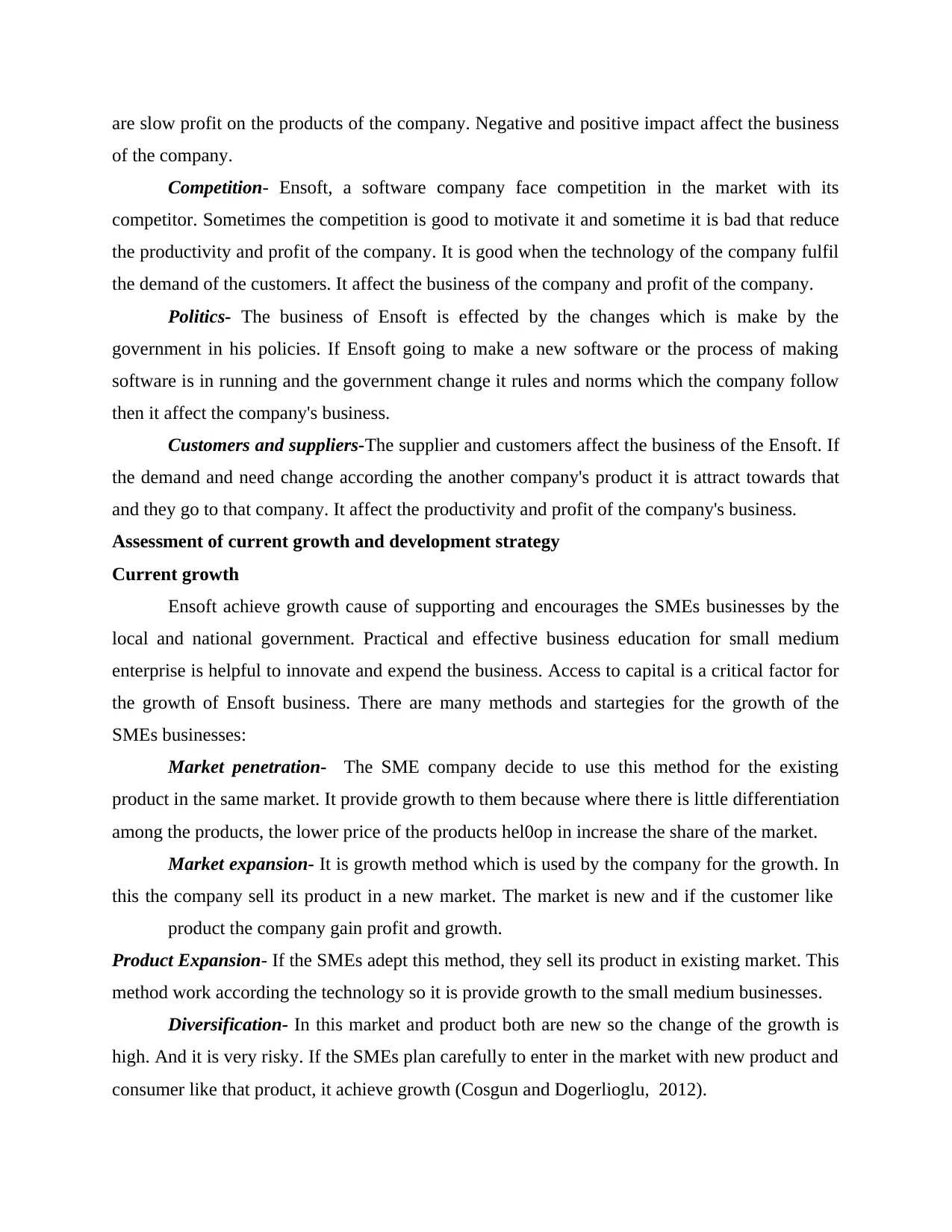
are slow profit on the products of the company. Negative and positive impact affect the business
of the company.
Competition- Ensoft, a software company face competition in the market with its
competitor. Sometimes the competition is good to motivate it and sometime it is bad that reduce
the productivity and profit of the company. It is good when the technology of the company fulfil
the demand of the customers. It affect the business of the company and profit of the company.
Politics- The business of Ensoft is effected by the changes which is make by the
government in his policies. If Ensoft going to make a new software or the process of making
software is in running and the government change it rules and norms which the company follow
then it affect the company's business.
Customers and suppliers-The supplier and customers affect the business of the Ensoft. If
the demand and need change according the another company's product it is attract towards that
and they go to that company. It affect the productivity and profit of the company's business.
Assessment of current growth and development strategy
Current growth
Ensoft achieve growth cause of supporting and encourages the SMEs businesses by the
local and national government. Practical and effective business education for small medium
enterprise is helpful to innovate and expend the business. Access to capital is a critical factor for
the growth of Ensoft business. There are many methods and startegies for the growth of the
SMEs businesses:
Market penetration- The SME company decide to use this method for the existing
product in the same market. It provide growth to them because where there is little differentiation
among the products, the lower price of the products hel0op in increase the share of the market.
Market expansion- It is growth method which is used by the company for the growth. In
this the company sell its product in a new market. The market is new and if the customer like
product the company gain profit and growth.
Product Expansion- If the SMEs adept this method, they sell its product in existing market. This
method work according the technology so it is provide growth to the small medium businesses.
Diversification- In this market and product both are new so the change of the growth is
high. And it is very risky. If the SMEs plan carefully to enter in the market with new product and
consumer like that product, it achieve growth (Cosgun and Dogerlioglu, 2012).
of the company.
Competition- Ensoft, a software company face competition in the market with its
competitor. Sometimes the competition is good to motivate it and sometime it is bad that reduce
the productivity and profit of the company. It is good when the technology of the company fulfil
the demand of the customers. It affect the business of the company and profit of the company.
Politics- The business of Ensoft is effected by the changes which is make by the
government in his policies. If Ensoft going to make a new software or the process of making
software is in running and the government change it rules and norms which the company follow
then it affect the company's business.
Customers and suppliers-The supplier and customers affect the business of the Ensoft. If
the demand and need change according the another company's product it is attract towards that
and they go to that company. It affect the productivity and profit of the company's business.
Assessment of current growth and development strategy
Current growth
Ensoft achieve growth cause of supporting and encourages the SMEs businesses by the
local and national government. Practical and effective business education for small medium
enterprise is helpful to innovate and expend the business. Access to capital is a critical factor for
the growth of Ensoft business. There are many methods and startegies for the growth of the
SMEs businesses:
Market penetration- The SME company decide to use this method for the existing
product in the same market. It provide growth to them because where there is little differentiation
among the products, the lower price of the products hel0op in increase the share of the market.
Market expansion- It is growth method which is used by the company for the growth. In
this the company sell its product in a new market. The market is new and if the customer like
product the company gain profit and growth.
Product Expansion- If the SMEs adept this method, they sell its product in existing market. This
method work according the technology so it is provide growth to the small medium businesses.
Diversification- In this market and product both are new so the change of the growth is
high. And it is very risky. If the SMEs plan carefully to enter in the market with new product and
consumer like that product, it achieve growth (Cosgun and Dogerlioglu, 2012).
Paraphrase This Document
Need a fresh take? Get an instant paraphrase of this document with our AI Paraphraser
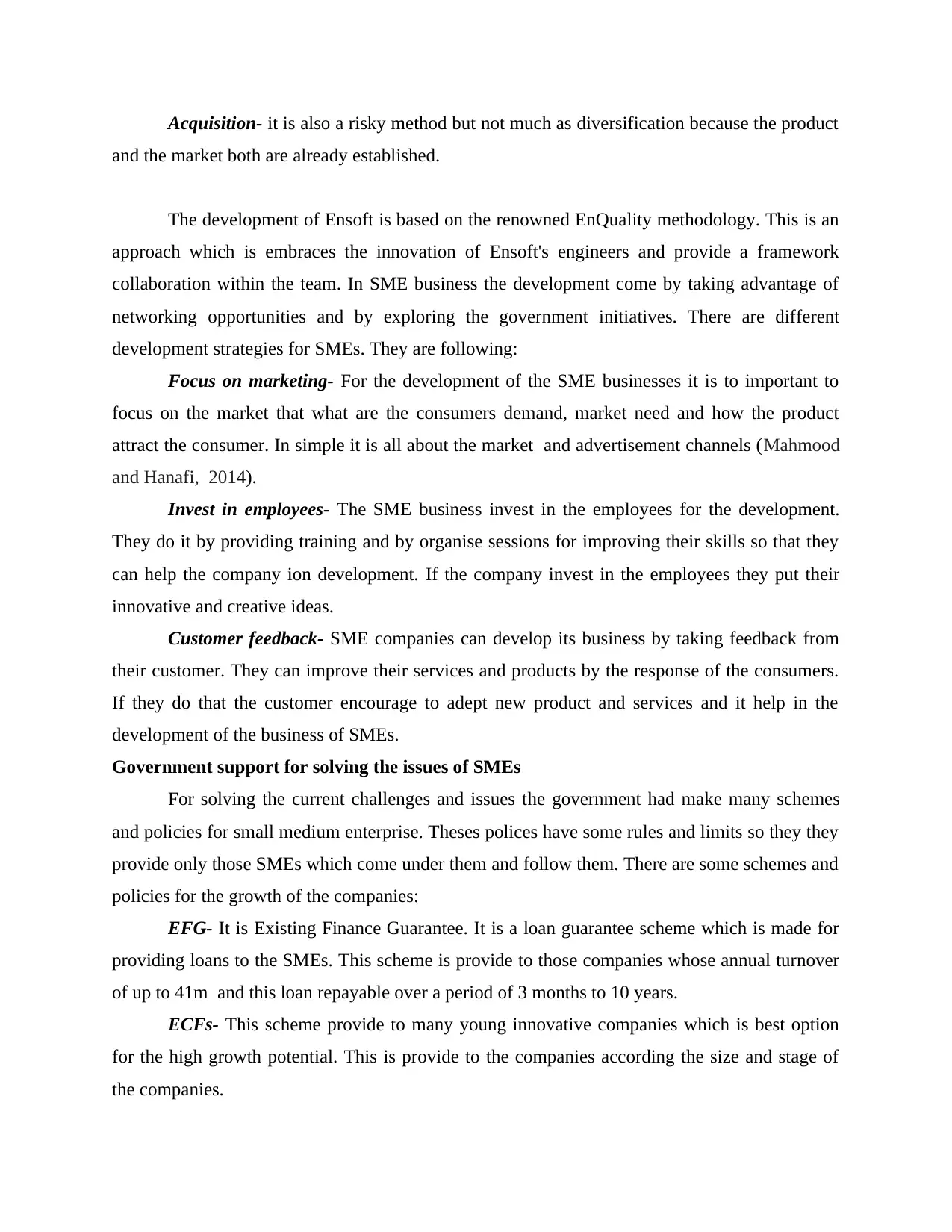
Acquisition- it is also a risky method but not much as diversification because the product
and the market both are already established.
The development of Ensoft is based on the renowned EnQuality methodology. This is an
approach which is embraces the innovation of Ensoft's engineers and provide a framework
collaboration within the team. In SME business the development come by taking advantage of
networking opportunities and by exploring the government initiatives. There are different
development strategies for SMEs. They are following:
Focus on marketing- For the development of the SME businesses it is to important to
focus on the market that what are the consumers demand, market need and how the product
attract the consumer. In simple it is all about the market and advertisement channels (Mahmood
and Hanafi, 2014).
Invest in employees- The SME business invest in the employees for the development.
They do it by providing training and by organise sessions for improving their skills so that they
can help the company ion development. If the company invest in the employees they put their
innovative and creative ideas.
Customer feedback- SME companies can develop its business by taking feedback from
their customer. They can improve their services and products by the response of the consumers.
If they do that the customer encourage to adept new product and services and it help in the
development of the business of SMEs.
Government support for solving the issues of SMEs
For solving the current challenges and issues the government had make many schemes
and policies for small medium enterprise. Theses polices have some rules and limits so they they
provide only those SMEs which come under them and follow them. There are some schemes and
policies for the growth of the companies:
EFG- It is Existing Finance Guarantee. It is a loan guarantee scheme which is made for
providing loans to the SMEs. This scheme is provide to those companies whose annual turnover
of up to 41m and this loan repayable over a period of 3 months to 10 years.
ECFs- This scheme provide to many young innovative companies which is best option
for the high growth potential. This is provide to the companies according the size and stage of
the companies.
and the market both are already established.
The development of Ensoft is based on the renowned EnQuality methodology. This is an
approach which is embraces the innovation of Ensoft's engineers and provide a framework
collaboration within the team. In SME business the development come by taking advantage of
networking opportunities and by exploring the government initiatives. There are different
development strategies for SMEs. They are following:
Focus on marketing- For the development of the SME businesses it is to important to
focus on the market that what are the consumers demand, market need and how the product
attract the consumer. In simple it is all about the market and advertisement channels (Mahmood
and Hanafi, 2014).
Invest in employees- The SME business invest in the employees for the development.
They do it by providing training and by organise sessions for improving their skills so that they
can help the company ion development. If the company invest in the employees they put their
innovative and creative ideas.
Customer feedback- SME companies can develop its business by taking feedback from
their customer. They can improve their services and products by the response of the consumers.
If they do that the customer encourage to adept new product and services and it help in the
development of the business of SMEs.
Government support for solving the issues of SMEs
For solving the current challenges and issues the government had make many schemes
and policies for small medium enterprise. Theses polices have some rules and limits so they they
provide only those SMEs which come under them and follow them. There are some schemes and
policies for the growth of the companies:
EFG- It is Existing Finance Guarantee. It is a loan guarantee scheme which is made for
providing loans to the SMEs. This scheme is provide to those companies whose annual turnover
of up to 41m and this loan repayable over a period of 3 months to 10 years.
ECFs- This scheme provide to many young innovative companies which is best option
for the high growth potential. This is provide to the companies according the size and stage of
the companies.
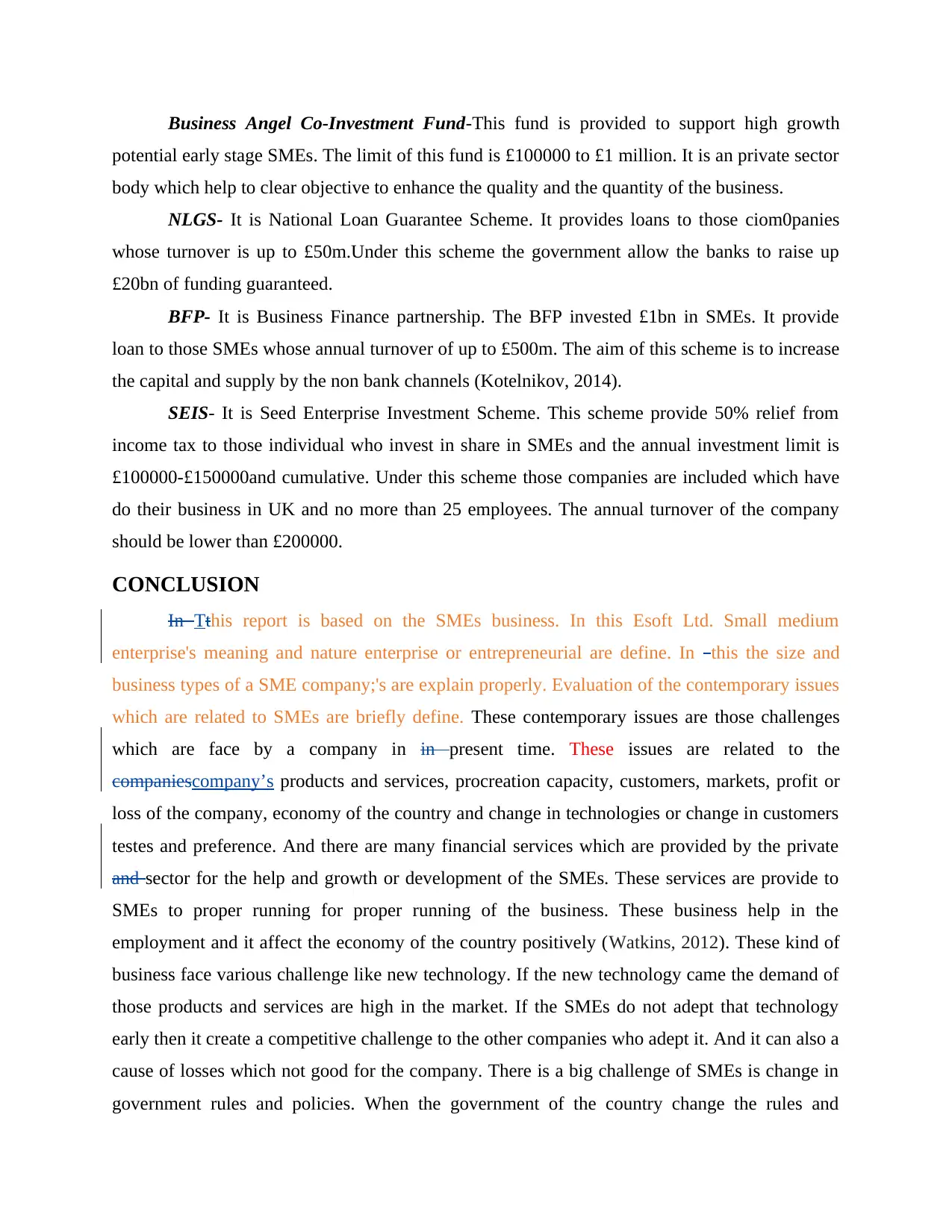
Business Angel Co-Investment Fund-This fund is provided to support high growth
potential early stage SMEs. The limit of this fund is £100000 to £1 million. It is an private sector
body which help to clear objective to enhance the quality and the quantity of the business.
NLGS- It is National Loan Guarantee Scheme. It provides loans to those ciom0panies
whose turnover is up to £50m.Under this scheme the government allow the banks to raise up
£20bn of funding guaranteed.
BFP- It is Business Finance partnership. The BFP invested £1bn in SMEs. It provide
loan to those SMEs whose annual turnover of up to £500m. The aim of this scheme is to increase
the capital and supply by the non bank channels (Kotelnikov, 2014).
SEIS- It is Seed Enterprise Investment Scheme. This scheme provide 50% relief from
income tax to those individual who invest in share in SMEs and the annual investment limit is
£100000-£150000and cumulative. Under this scheme those companies are included which have
do their business in UK and no more than 25 employees. The annual turnover of the company
should be lower than £200000.
CONCLUSION
In Tthis report is based on the SMEs business. In this Esoft Ltd. Small medium
enterprise's meaning and nature enterprise or entrepreneurial are define. In this the size and
business types of a SME company;'s are explain properly. Evaluation of the contemporary issues
which are related to SMEs are briefly define. These contemporary issues are those challenges
which are face by a company in in present time. These issues are related to the
companiescompany’s products and services, procreation capacity, customers, markets, profit or
loss of the company, economy of the country and change in technologies or change in customers
testes and preference. And there are many financial services which are provided by the private
and sector for the help and growth or development of the SMEs. These services are provide to
SMEs to proper running for proper running of the business. These business help in the
employment and it affect the economy of the country positively (Watkins, 2012). These kind of
business face various challenge like new technology. If the new technology came the demand of
those products and services are high in the market. If the SMEs do not adept that technology
early then it create a competitive challenge to the other companies who adept it. And it can also a
cause of losses which not good for the company. There is a big challenge of SMEs is change in
government rules and policies. When the government of the country change the rules and
potential early stage SMEs. The limit of this fund is £100000 to £1 million. It is an private sector
body which help to clear objective to enhance the quality and the quantity of the business.
NLGS- It is National Loan Guarantee Scheme. It provides loans to those ciom0panies
whose turnover is up to £50m.Under this scheme the government allow the banks to raise up
£20bn of funding guaranteed.
BFP- It is Business Finance partnership. The BFP invested £1bn in SMEs. It provide
loan to those SMEs whose annual turnover of up to £500m. The aim of this scheme is to increase
the capital and supply by the non bank channels (Kotelnikov, 2014).
SEIS- It is Seed Enterprise Investment Scheme. This scheme provide 50% relief from
income tax to those individual who invest in share in SMEs and the annual investment limit is
£100000-£150000and cumulative. Under this scheme those companies are included which have
do their business in UK and no more than 25 employees. The annual turnover of the company
should be lower than £200000.
CONCLUSION
In Tthis report is based on the SMEs business. In this Esoft Ltd. Small medium
enterprise's meaning and nature enterprise or entrepreneurial are define. In this the size and
business types of a SME company;'s are explain properly. Evaluation of the contemporary issues
which are related to SMEs are briefly define. These contemporary issues are those challenges
which are face by a company in in present time. These issues are related to the
companiescompany’s products and services, procreation capacity, customers, markets, profit or
loss of the company, economy of the country and change in technologies or change in customers
testes and preference. And there are many financial services which are provided by the private
and sector for the help and growth or development of the SMEs. These services are provide to
SMEs to proper running for proper running of the business. These business help in the
employment and it affect the economy of the country positively (Watkins, 2012). These kind of
business face various challenge like new technology. If the new technology came the demand of
those products and services are high in the market. If the SMEs do not adept that technology
early then it create a competitive challenge to the other companies who adept it. And it can also a
cause of losses which not good for the company. There is a big challenge of SMEs is change in
government rules and policies. When the government of the country change the rules and
⊘ This is a preview!⊘
Do you want full access?
Subscribe today to unlock all pages.

Trusted by 1+ million students worldwide
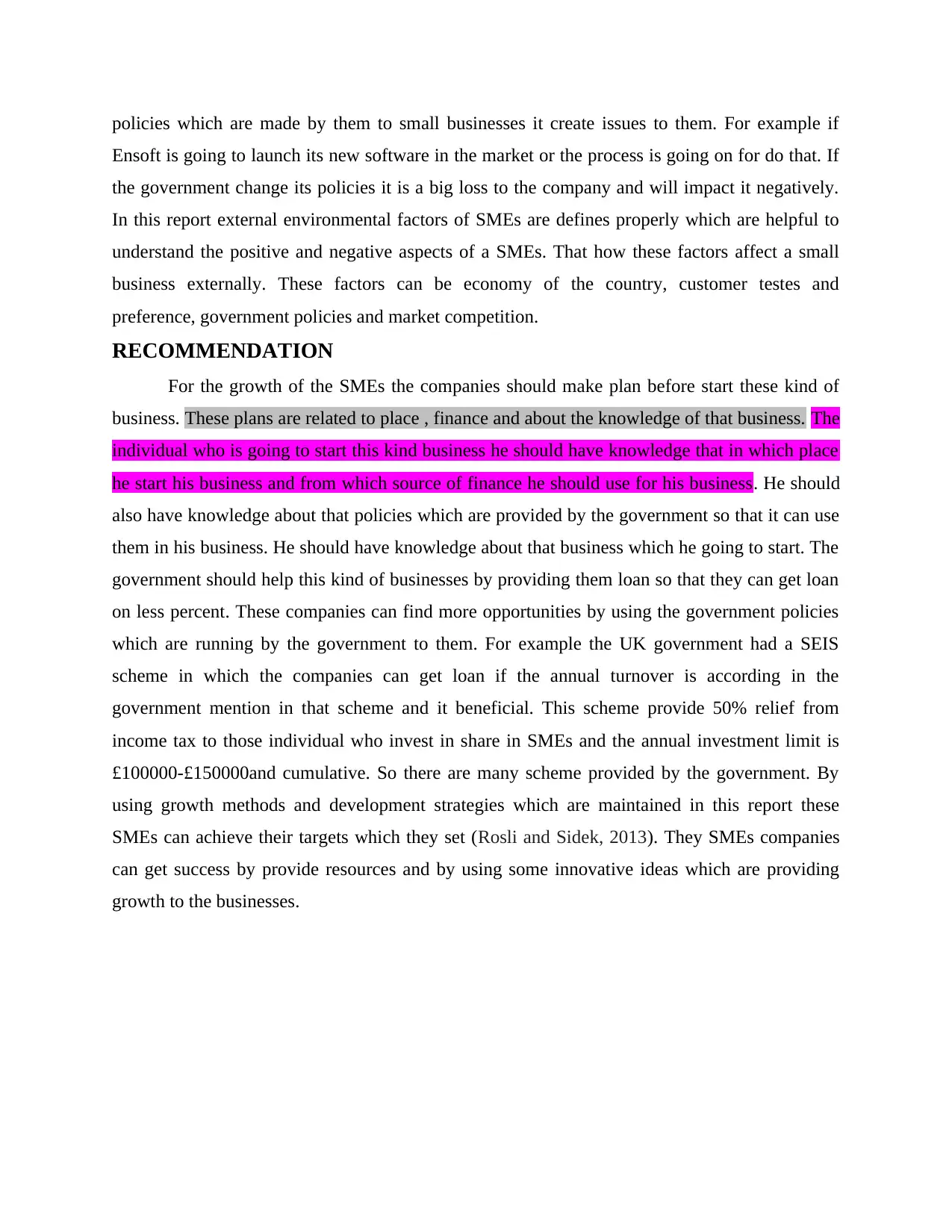
policies which are made by them to small businesses it create issues to them. For example if
Ensoft is going to launch its new software in the market or the process is going on for do that. If
the government change its policies it is a big loss to the company and will impact it negatively.
In this report external environmental factors of SMEs are defines properly which are helpful to
understand the positive and negative aspects of a SMEs. That how these factors affect a small
business externally. These factors can be economy of the country, customer testes and
preference, government policies and market competition.
RECOMMENDATION
For the growth of the SMEs the companies should make plan before start these kind of
business. These plans are related to place , finance and about the knowledge of that business. The
individual who is going to start this kind business he should have knowledge that in which place
he start his business and from which source of finance he should use for his business. He should
also have knowledge about that policies which are provided by the government so that it can use
them in his business. He should have knowledge about that business which he going to start. The
government should help this kind of businesses by providing them loan so that they can get loan
on less percent. These companies can find more opportunities by using the government policies
which are running by the government to them. For example the UK government had a SEIS
scheme in which the companies can get loan if the annual turnover is according in the
government mention in that scheme and it beneficial. This scheme provide 50% relief from
income tax to those individual who invest in share in SMEs and the annual investment limit is
£100000-£150000and cumulative. So there are many scheme provided by the government. By
using growth methods and development strategies which are maintained in this report these
SMEs can achieve their targets which they set (Rosli and Sidek, 2013). They SMEs companies
can get success by provide resources and by using some innovative ideas which are providing
growth to the businesses.
Ensoft is going to launch its new software in the market or the process is going on for do that. If
the government change its policies it is a big loss to the company and will impact it negatively.
In this report external environmental factors of SMEs are defines properly which are helpful to
understand the positive and negative aspects of a SMEs. That how these factors affect a small
business externally. These factors can be economy of the country, customer testes and
preference, government policies and market competition.
RECOMMENDATION
For the growth of the SMEs the companies should make plan before start these kind of
business. These plans are related to place , finance and about the knowledge of that business. The
individual who is going to start this kind business he should have knowledge that in which place
he start his business and from which source of finance he should use for his business. He should
also have knowledge about that policies which are provided by the government so that it can use
them in his business. He should have knowledge about that business which he going to start. The
government should help this kind of businesses by providing them loan so that they can get loan
on less percent. These companies can find more opportunities by using the government policies
which are running by the government to them. For example the UK government had a SEIS
scheme in which the companies can get loan if the annual turnover is according in the
government mention in that scheme and it beneficial. This scheme provide 50% relief from
income tax to those individual who invest in share in SMEs and the annual investment limit is
£100000-£150000and cumulative. So there are many scheme provided by the government. By
using growth methods and development strategies which are maintained in this report these
SMEs can achieve their targets which they set (Rosli and Sidek, 2013). They SMEs companies
can get success by provide resources and by using some innovative ideas which are providing
growth to the businesses.
Paraphrase This Document
Need a fresh take? Get an instant paraphrase of this document with our AI Paraphraser

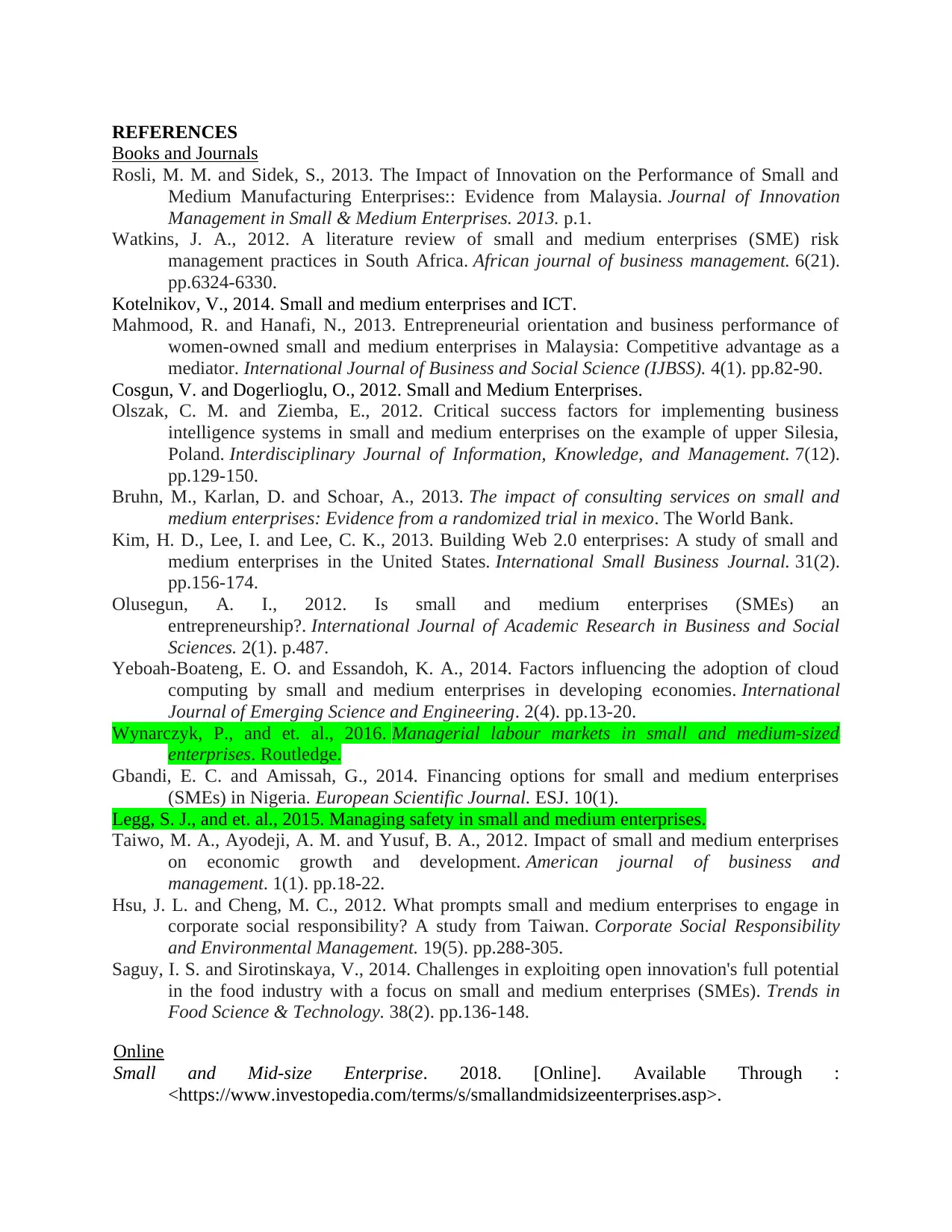
REFERENCES
Books and Journals
Rosli, M. M. and Sidek, S., 2013. The Impact of Innovation on the Performance of Small and
Medium Manufacturing Enterprises:: Evidence from Malaysia. Journal of Innovation
Management in Small & Medium Enterprises. 2013. p.1.
Watkins, J. A., 2012. A literature review of small and medium enterprises (SME) risk
management practices in South Africa. African journal of business management. 6(21).
pp.6324-6330.
Kotelnikov, V., 2014. Small and medium enterprises and ICT.
Mahmood, R. and Hanafi, N., 2013. Entrepreneurial orientation and business performance of
women-owned small and medium enterprises in Malaysia: Competitive advantage as a
mediator. International Journal of Business and Social Science (IJBSS). 4(1). pp.82-90.
Cosgun, V. and Dogerlioglu, O., 2012. Small and Medium Enterprises.
Olszak, C. M. and Ziemba, E., 2012. Critical success factors for implementing business
intelligence systems in small and medium enterprises on the example of upper Silesia,
Poland. Interdisciplinary Journal of Information, Knowledge, and Management. 7(12).
pp.129-150.
Bruhn, M., Karlan, D. and Schoar, A., 2013. The impact of consulting services on small and
medium enterprises: Evidence from a randomized trial in mexico. The World Bank.
Kim, H. D., Lee, I. and Lee, C. K., 2013. Building Web 2.0 enterprises: A study of small and
medium enterprises in the United States. International Small Business Journal. 31(2).
pp.156-174.
Olusegun, A. I., 2012. Is small and medium enterprises (SMEs) an
entrepreneurship?. International Journal of Academic Research in Business and Social
Sciences. 2(1). p.487.
Yeboah-Boateng, E. O. and Essandoh, K. A., 2014. Factors influencing the adoption of cloud
computing by small and medium enterprises in developing economies. International
Journal of Emerging Science and Engineering. 2(4). pp.13-20.
Wynarczyk, P., and et. al., 2016. Managerial labour markets in small and medium-sized
enterprises. Routledge.
Gbandi, E. C. and Amissah, G., 2014. Financing options for small and medium enterprises
(SMEs) in Nigeria. European Scientific Journal. ESJ. 10(1).
Legg, S. J., and et. al., 2015. Managing safety in small and medium enterprises.
Taiwo, M. A., Ayodeji, A. M. and Yusuf, B. A., 2012. Impact of small and medium enterprises
on economic growth and development. American journal of business and
management. 1(1). pp.18-22.
Hsu, J. L. and Cheng, M. C., 2012. What prompts small and medium enterprises to engage in
corporate social responsibility? A study from Taiwan. Corporate Social Responsibility
and Environmental Management. 19(5). pp.288-305.
Saguy, I. S. and Sirotinskaya, V., 2014. Challenges in exploiting open innovation's full potential
in the food industry with a focus on small and medium enterprises (SMEs). Trends in
Food Science & Technology. 38(2). pp.136-148.
Online
Small and Mid-size Enterprise. 2018. [Online]. Available Through :
<https://www.investopedia.com/terms/s/smallandmidsizeenterprises.asp>.
Books and Journals
Rosli, M. M. and Sidek, S., 2013. The Impact of Innovation on the Performance of Small and
Medium Manufacturing Enterprises:: Evidence from Malaysia. Journal of Innovation
Management in Small & Medium Enterprises. 2013. p.1.
Watkins, J. A., 2012. A literature review of small and medium enterprises (SME) risk
management practices in South Africa. African journal of business management. 6(21).
pp.6324-6330.
Kotelnikov, V., 2014. Small and medium enterprises and ICT.
Mahmood, R. and Hanafi, N., 2013. Entrepreneurial orientation and business performance of
women-owned small and medium enterprises in Malaysia: Competitive advantage as a
mediator. International Journal of Business and Social Science (IJBSS). 4(1). pp.82-90.
Cosgun, V. and Dogerlioglu, O., 2012. Small and Medium Enterprises.
Olszak, C. M. and Ziemba, E., 2012. Critical success factors for implementing business
intelligence systems in small and medium enterprises on the example of upper Silesia,
Poland. Interdisciplinary Journal of Information, Knowledge, and Management. 7(12).
pp.129-150.
Bruhn, M., Karlan, D. and Schoar, A., 2013. The impact of consulting services on small and
medium enterprises: Evidence from a randomized trial in mexico. The World Bank.
Kim, H. D., Lee, I. and Lee, C. K., 2013. Building Web 2.0 enterprises: A study of small and
medium enterprises in the United States. International Small Business Journal. 31(2).
pp.156-174.
Olusegun, A. I., 2012. Is small and medium enterprises (SMEs) an
entrepreneurship?. International Journal of Academic Research in Business and Social
Sciences. 2(1). p.487.
Yeboah-Boateng, E. O. and Essandoh, K. A., 2014. Factors influencing the adoption of cloud
computing by small and medium enterprises in developing economies. International
Journal of Emerging Science and Engineering. 2(4). pp.13-20.
Wynarczyk, P., and et. al., 2016. Managerial labour markets in small and medium-sized
enterprises. Routledge.
Gbandi, E. C. and Amissah, G., 2014. Financing options for small and medium enterprises
(SMEs) in Nigeria. European Scientific Journal. ESJ. 10(1).
Legg, S. J., and et. al., 2015. Managing safety in small and medium enterprises.
Taiwo, M. A., Ayodeji, A. M. and Yusuf, B. A., 2012. Impact of small and medium enterprises
on economic growth and development. American journal of business and
management. 1(1). pp.18-22.
Hsu, J. L. and Cheng, M. C., 2012. What prompts small and medium enterprises to engage in
corporate social responsibility? A study from Taiwan. Corporate Social Responsibility
and Environmental Management. 19(5). pp.288-305.
Saguy, I. S. and Sirotinskaya, V., 2014. Challenges in exploiting open innovation's full potential
in the food industry with a focus on small and medium enterprises (SMEs). Trends in
Food Science & Technology. 38(2). pp.136-148.
Online
Small and Mid-size Enterprise. 2018. [Online]. Available Through :
<https://www.investopedia.com/terms/s/smallandmidsizeenterprises.asp>.
⊘ This is a preview!⊘
Do you want full access?
Subscribe today to unlock all pages.

Trusted by 1+ million students worldwide
1 out of 12
Related Documents
Your All-in-One AI-Powered Toolkit for Academic Success.
+13062052269
info@desklib.com
Available 24*7 on WhatsApp / Email
![[object Object]](/_next/static/media/star-bottom.7253800d.svg)
Unlock your academic potential
Copyright © 2020–2025 A2Z Services. All Rights Reserved. Developed and managed by ZUCOL.




